|
C.W. Cousland signed the Tucson Register once, on Wednesday, September 19, 1928 at 1:10PM. He arrived solo in the Douglas O-2H, 28-174. Based at Ft. Crockett, TX, he arrived at Tucson from Rockwell Field, San Diego, CA. He remained overnight and departed eastbound the next morning at 8AM for Ft. Sill, OK, Post Field. He cited no reason for his flight.
Cousland was born at Pinos Altos, NM on August 19, 1900. The 1910 U.S. Census, his first, placed him at age 10 living in Deming, NM with his father, Walter (28; 1880–1942), mother Annie (26) and two younger brothers and a younger sister. His father's occupation was coded as "Machinist" with the "Railroad." An unusual finding is that the Census form recorded the "Number of years of present marriage" as 12 for his parents. If you do the math, they were married when Walter was 16 and Annie 14 years old. And Annie was coded as the mother of six children, four of whom were presently living. I could find no 1920 Census data for Cousland.
He did register with the draft for WWI as indicated in his registration card, below, dated September 12, 1918. We learn that he was of medium height, slender build and brown hair and eyes. He worked as a timekeeper for the J.W. Thompson Construction Company at the time.
C.W. Cousland, WWI Draft Registration, September 12, 1918 (Source: ancestry.com)
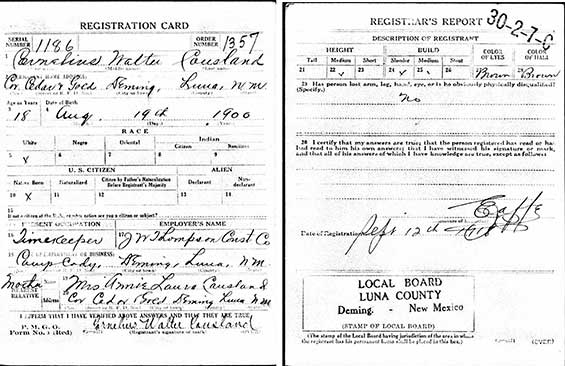 |
The Brooklyn Daily Eagle, August 13, 1926 (Source: newspapers.com)
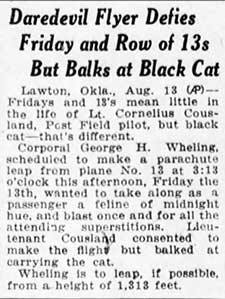 |
Cousland's early education was in Deming. He was appointed from New Mexico to the U.S. Military Academy on July 20, 1920, and upon graduation, June 12, 1924, was commissioned a second lieutenant in the air service.
The 1926 city directory for Lawton, OK placed him living as a 2nd lieutenant in a Post Field residence. One article appeared in the Brooklyn Daily Eagle, August 13, 1926, right, that documented one of his activites. Rather than being superstitious, I would wager that he didn't want the cat in the cockpit because he didn't want to be alone to deal with its possibly unpredictable behavior after the parachutist jumped. Similar articles appeared in several other newspapers across the country. Sometime after 1926 he was married to Lucille McTaggart while at Ft. Sill. She was from Lawton, OK.
He was posted to Bolling Field, DC in 1929 and promoted to first lieutenant on January 27, 1930. I found no Census data for 1930. The 1931 city directory for Washington, DC placed him living with Lucille at 1907 P Street. They were divorced after WWII. At some point he married Kathryn Storts, as she was identified as his wife on his death certificate, below.
At Bolling Field, he was the pilot for the Secretary of War Patrick Hurley, members of the House Military Affairs Committee and other officials.
The New York Times, November 21, 1930 (Source: NYT)
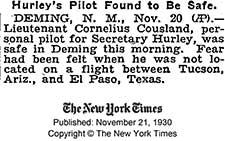 |
A news article from The New York Times (NYT), November 21, 1930, left, reported a mishap when Cousland was flying between Tucson and El Paso, TX. There was no indication in the Register that he landed at Tucson. A day or so later he reported to Bolling Field by telephone from Deming, NM that he had landed there because of foul weather. He was on a cross-country flight from Seattle, WA to Washington, DC. He stayed with friends overnight (he was raised in Deming) and departed the next day.
Deming Headlight (NM), April 15, 1932 (Source: newspapers.com)
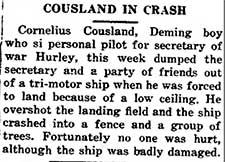 |
Another mishap occurred in 1932, right, when the trimotor airplane Cousland was flying for Hurley crashed under a low ceiling. No one was injured.
Several flights with Hurley were documented in the Air Corps Newsletters (ACNL) of the time. For example, on February 10, 1931, when he flew Secretary Hurley to Topeka, KS. On July 1, 1931 he flew the Secretary to Wright Field, Dayton, OH on his way from Bolling Field to Muskogee, OK.
On November 19th he and two other pilots ferried three BT-2B aircraft to San Antonio, TX from Bolling Field and returned by rail. In January, 1932, the following appeared in the ACNL. Why the Secretary of War had to understand the headwaters of the creeks of America is unknown. Regardless, the flying was probably challenging and pleasant at once.
Air Corps Newsletter, January, 1932 (Source: Webmaster)
 |
Washington Post, July 11, 1931 (Source:
WAPO)
 |
The Washington Post (WAPO), July 11, 1931 cited a VIP event he attended with Secretary Hurley, left. Note other Register signers in attendance: F. Trubee Davison, James Fechet, W.H. Hale, Ira Eaker and Jimmy Doolittle.
Interestingly, Cousland signed the Register of Floyd Bennett Field on August 10, 1933 flying a Douglas O-38F (one of nine of the type to land that day). His F model was an unarmed staff liaison aircraft with an enclosed canopy. He left no record of passengers or the reason for his flight. Please direct your browser to the link and examine page four of that Register. He was one of 17 other military aircraft landing that day, nine of which noted their home base as Bolling Field. He completed four years of duty at Bolling Field, DC in early 1934.
He was then posted to the Canal Zone in early 1934 where he served with the 6th Composite Group, France Field until 1936. The logo of the 6th Composite group is below left and right. He probably wore a handsome set of collar insignia like those at left. These collar insignia were worn by your Webmaster's father, who was stationed at France Field with the 6th Composite Group in 1938-39.
6th Composite Group, Collar Insignia, Panama, C.Z., 1934 (Source: Webmaster)
 |
6th Composite Group, Panama, C.Z., 1934 (Source: Webmaster)
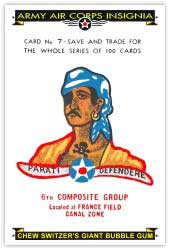 |
The New York Times, January 3, 1935 (Source: NYT)
 |
While in the Canal Zone, Cousland earned the Distiguished Flying Cross on May 31, 1934 The circumstances around his reward were grim, as documented in The New York Times, June 1, 1934, left. The award was formally announced in The New York Times, January 3, 1935, right. Notice of his award appeared in numerous papers. A photograph of him appeared with the announcement in the Hazelton Plain Speaker (PA), January 10, 1935, below right.
Hazelton Plain Speaker (PA), January 10, 1935 (Source: newspapers.com)
 |
His award was accompanied by the following citation.
Awards: Distinguished Flying Cross
Awarded for actions during the Peace Time Awards
The President of the United States of America, authorized by Act of Congress, July 2, 1926, takes pleasure in presenting the Distinguished Flying Cross to First Lieutenant (Air Corps) Cornelius Walter Cousland, U.S. Army Air Corps, for heroism and extraordinary achievement while participating in an aerial flight while piloting a Douglas amphibian over the Panama Canal Zone, on 31 May 1934. When about 100 yards from the edge of Gatun Lake, at an altitude of approximately 1,400 feet, mechanical failure caused a portion of the right motor to penetrate the pilot's cockpit with such force that the copilot was fatally injured and fell across Lieutenant Cousland and the controls. The plane started to spin but Lieutenant Cousland, disregarding his own serious injuries from flying glass, ordered his passengers to retain their seats and by his courage, presence of mind, and complete mastery of the art of piloting, maneuvered the disabled aircraft to a safe landing on the surface of the stump-studded lake.
General Orders: War Department, General Orders No. 3 (1935)
Action Date: May 31, 1934
Service: Army Air Forces Rank: First Lieutenant |
Danville Bee (VA), February 15, 1938 (Source: newspapers.com)
 |
Cousland was promoted to captain the following year on August 1, 1935. His promotion was announced in The New York Times, August 15, 1935 among a typical list of hundreds of other army promotions.
On February 17, 1938, He participated with a group of 49 officers and men in a good-will flight from New York to Buenos Aires, Argentina. The flight consisted initially of six four-engined B-17 bombers. The beginning of the flight was documented in many newspapers across the country. The Danville Bee (VA) of February 15, 1938 was typical, left.
The flight proceeded from Langley, VA to Fort Lauderdale, FL and thence almost due south. The route of flight was across Central America to Equador, Peru, Chile and then eastward across the continent to Buenos Aires, Argentina. Navigation was by dead reckoning. Cousland's bomber was number 82, commanded by fellow Register pilot Archibald Y. Smith. His fellow crew were listed as follows
Their flight was billed as a "Goodwill Flight," but there was an element of politics involved.
Ironwood City Globe (MI), February 22, 1938 (Source: newspapers.com)
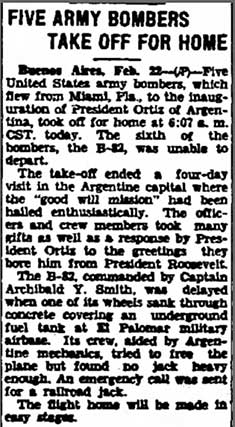 |
First, it was Argentina President Ortiz's birthday celebration, and the Goodwill Flight was allegedly to help celebrate that. But, second, Argentina was showing some affinity toward developing relations with Germany. Given the proximity to the onset of WWII, the U.S. wanted to provide a show of power to Argentina. Note the last sentence of the article at left.
The flight departed back north on February 22, 1938 as reported in the Ironwood City Globe (MI) of that date, right. Notice that Cousland's aircraft was delayed in its departure from El Palomar air base because one of its wheels sank through a thin concrete pad.
Upon his return from South America, Cousland continued to fly the B-17 and appeared in the May 17, 1938 Harrisburg Telegraph, below, flying in formation over New York City.
Harrisburg Telegraph (PA), May 17, 1938 (Source: newspapers.com)
 |
The New York Times, May 19, 1938 (Source: NYT)
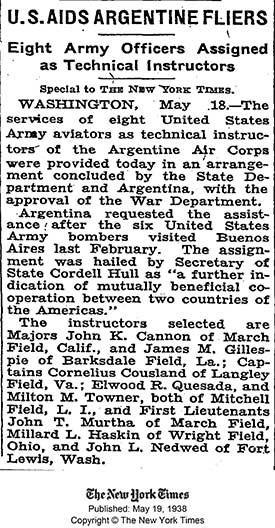 |
The February Goodwill Flight was politically if not financially lucrative for the U.S. government. The New York Times of May 19, 1938, left, reported the assignment of eight U.S. army aviators to act as technical instructors for the Argentine Air Corps. Cousland was among them. Note mention of fellow Register pilots John K. Cannon and Elwood Quesada.
Mount Carmel Item (PA), July 13, 1944 (Source: newspapers.com)
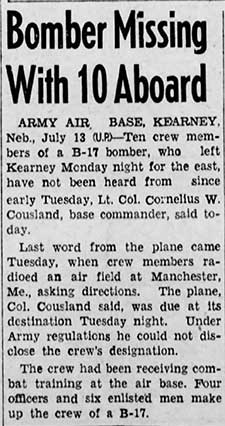 |
I found no Census data for 1940. During WWII, Cousland was the first Commanding officer 97th Bomb Group in February 1942. Shortly after this time, the 97th was moved to England to enter the European conflict. It is not clear if Cousland was involved with the move. As of July 1942, the 97th was under a different commander.
In 1944, he was the commander of the army air base at Kearny, NB. The article at right from the Mount Carmel Item (PA) of July 13, 1944 cited a missing aircraft from his organization. Note that he had been promoted to lieutenant colonel.
For achievements I was unable to discover, he was awarded an oak leaf cluster for his Distinguished Flying Cross from 1934. The award statement is below, but speaks of the accomplishment in only general terms.
Distinguished Flying Cross
Awarded for actions during the World War II
Colonel (Air Corps) Cornelius Walter Cousland, United States Army Air Forces, was awarded a Bronze Oak Leaf Cluster in lieu of a Second Award of the Distinguished Flying Cross for extraordinary achievement while participating in aerial flight during World War II.
General Orders: United States Military Academy Register of Graduates
Action Date: World War II Service: Army Air Forces
Rank: Colonel
Company: G-3
Regiment: 12th Fighter Command |
An article in the Piqua Daily Call (OH), March 15, 1944 documented Cousland's work leading groups of B-17s from Labrador to England. The article described the difficulty of hopping these airplanes across the icy reaches of the North Atlantic Ocean. This work could be the reason for his award.
The Albuquerque Journal, August 24, 1946 (Source: newspapers.com)
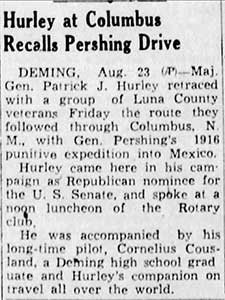 |
After WWII Cousland maintained his relationship with Patrick Hurley. The article at right from the Albuquerque Journal (NM), August 24, 1946 explains. Barely a year after the end of WWII, Hurley was running for the U.S. Senate. He chose Cousland to be his pilot. This accident occurred near Richmond, IN after Hurley gave a speech to the Indiana Republican Editorial Association. They were returning to Washington. Hurley continued to Washington by train.
C.W. Cousland, Arlington Grave Marker, June 29, 1959 (Source: findagrave.com)
CouslandMarker.jpg) |
I could find no information about his life after 1946. Cousland's relationship with Hurley was very close. Cousland had a son that he named Pat Hurley Cousland.
Cousland flew West from Ft. Bragg, NC, June 29, 1959. His grave marker at Arlington is at left. Wife Kathryn was buried next to him in 1978. His death certificate is below. The cause of his death was pancreatic cancer.
C.W. Cousland, Death Certificate, June 29, 1959 (Source: ancestry.com)
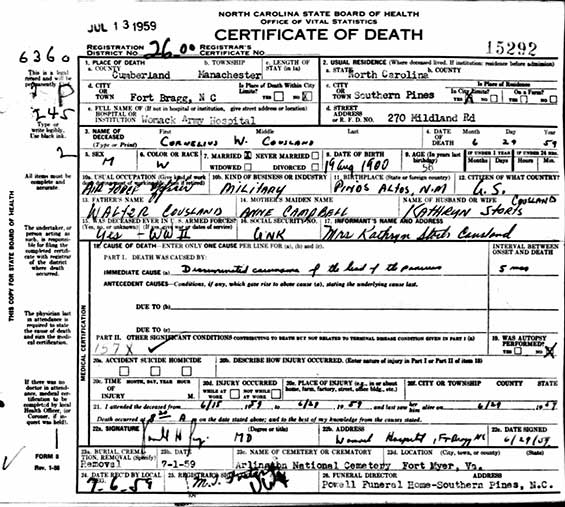 |
He was buried at Arlington National Cemetery July 2, 1959. His interment certificate from the cemetery is below.
C.W. Cousland, Arlington Cemetery Interment Certificate, July 2, 1959 (Source: ancestry.com)
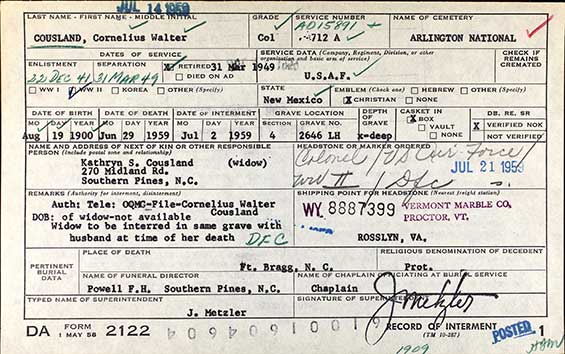 |
Cousland also signed the Peterson Field Register, Colorado Springs, CO sometime between October 9-20, 1932 (he did not write his arrival date in the Register). He flew the civilian Stinson SM-6000-B, NC10860.
---o0o---
Dossier 2.2.58
THIS PAGE UPLOADED: 06/13/17 REVISED: 12/11/18
|













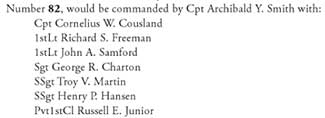





CouslandMarker.jpg)

